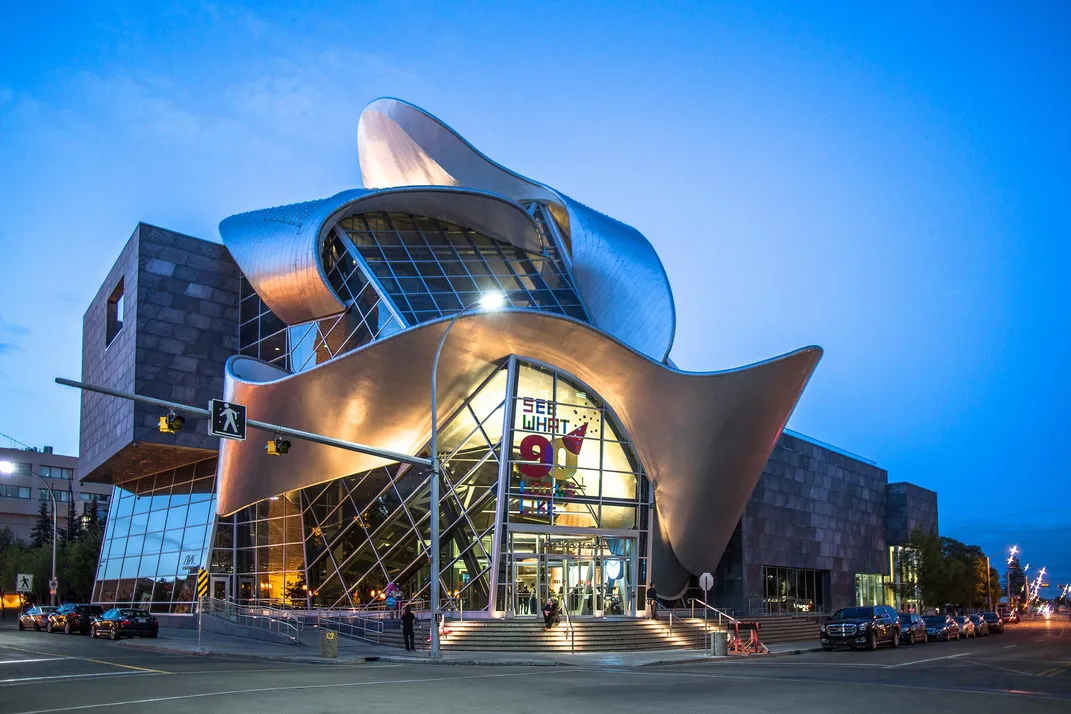New Study Offers Clues to Dominance of Curve-Filled Museum Designs
Architects are more likely than non-experts to deem curvilinear spaces beautiful, but less likely to enter curved over straight-edged rooms
:focal(516x253:517x254)/https://tf-cmsv2-smithsonianmag-media.s3.amazonaws.com/filer/03/1d/031d55a2-f16f-4a61-8801-d8e72bedb234/1024px-bilbao_-_guggenheim_aurore.jpg)
Curved edges abound in architecture—particularly when it comes to museums, with cultural institutions ranging from Spain’s Guggenheim Bilbao to France’s Louis Vuitton Foundation, Israel’s Design Museum Holon, Mexico’s Museum Soumaya and Canada’s Art Gallery of Alberta embracing undulating forms over sharp angles.
Interestingly, a new study published in Psychology of Aesthetics, Creativity, and the Arts suggests individuals’ responses to such curvilinear spaces differ based on their understanding of architecture, art history and interior design.
As Rachel Corbett reports for artnet News, researchers led by Oshin Vartanian of the University of Toronto found that 71 students without prior knowledge of these fields showed little preference for curvilinear versus rectilinear rooms. Participants who self-identified as professional architects or designers, however, consistently judged curved spaces to be more beautiful than straight-edged ones.
But when asked how likely they were to enter a curved versus rectangular room, non-experts overwhelmingly opted for the former. This may be because humans of all ages tend to exhibit an innate preference for curvilinear forms: In an interview with Alexa Samuels, founder of art startup Mercartto, Vartanian notes that wavy patterns are viewed as more “natural” than angular ones.
Vartanian and his team have previously researched the subject, which offers bread crumbs to the recent findings. In a 2013 study published in the Proceedings of the National Academy of Sciences, the team asked participants to view images of curve-filled versus rectilinear rooms while under observation in a brain-imaging machine. Not only did subjects continually consider rounded rooms to be more beautiful than straight-edged spaces, but they also exhibited heightened brain activity when looking at curved interiors. Crucially, this activity occurred in the anterior cingulate cortex, a neural region closely associated with emotion.

Summarizing the findings for The Globe and Mail, Dave McGinn outlines two possible explanations: One, supported by a separate 2007 study, posits that humans have developed a fear of sharp angles over time, with the potential danger represented by a straight versus rounded line triggering the brain’s amygdala, or fear center. The second theory emphasizes the prevalence of rounded features in the natural world, suggesting that our knowledge of such shapes has bred familiarity and, in turn, comfort.
“Curved buildings can point to nature, whereas angular buildings contrast with it,” Paul Silvia, a psychology expert from the University of North Carolina at Greensboro who was not involved in the 2013 study, tells CNN’s William Lee Adams. “Instead of blending into the environment or evoking natural themes, they stand apart from it by using one of the few shapes you never see in nature—a perfect box.”
In conjunction with earlier research, the latest study adds an intriguing wrinkle to conversations centering on curves. In a twist, the researchers also found that professionals differed from non-experts on their willingness to enter curved or rectangular rooms. Unlike non-experts, who may not have preferred curvilinear rooms but were more likely to enter them, the experts were equally willing to enter either type of space. It's possible that while those in the field can appreciate rounded forms on a purely aesthetic level, the expertise that guides this decision also bypasses unconscious links, stopping experts from equating curvature with certain cultural phenomena.
This leads us to the paradoxical conclusion suggested by the research: While the average individual may not exhibit a strong preference for curved shapes, the Guggenheim’s circular exterior appears to be more inviting to them than what Corbett of artnet terms “the boxy Brutalism” of the Met Breuer. And while experts assessing architectural edges are just as likely to visit the Guggenheim as they are the Met Breur, they make that choice in full acknowledgement of the Guggenheim’s seemingly superior aesthetic appeal.
/https://tf-cmsv2-smithsonianmag-media.s3.amazonaws.com/accounts/headshot/mellon.png)
/https://tf-cmsv2-smithsonianmag-media.s3.amazonaws.com/accounts/headshot/mellon.png)